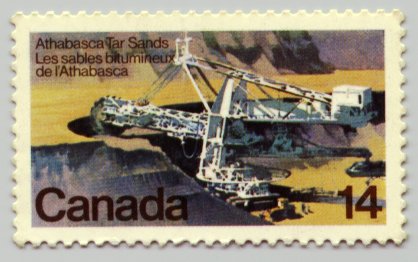Giant Earth-Movers
Today, we find some very big machines. The University of Houston's College of Engineering presents this series about the machines that make our civilization run, and the people whose ingenuity created them.
At the bookstore the other night, I was drawn to a coffee table picture book, Eric Orlemann's Giant Earth-Moving Equipment, filled with photos of steam shovels. I couldn't walk away from it.
The word steam shovel was used when I was a kid. You still saw steam-powered shovels with coal-fired vertical boilers. Today's big earth movers are diesel powered and they reach astonishing size, but they're used where few of us will see them. They're far too large for our highways. They're made by companies like Bucyrus-Erie, Marion, Krupp, and Hitachi. The really big ones could swallow steam-powered Mike Mulligan in one gulp.
The Marion 6360 stripping shovel is biggest of the lot. A single link from one of its eight crawler tracks weighs three and a half tons. It stands 21 stories high and its bucket can lift 270 tons of dirt -- twice the weight of a blue whale. Four of these rigs would outweigh the Titanic.
Size has fallen out of fashion in our technology. Today's high tech focuses on miniaturization. We can do surgery on DNA and store a pixel of information on a spot 500 atoms across. We know information lives on microscopic levels in our computers, but we hardly know these large earth-movers exist.
Yet they're out there -- vast drag lines, shovels, excavators. They build the heroic works of civil engineering. They reshape our world as they help make dams, canals, highway cuts. It's their role in mining we don't want to know about. Before legislation forced coal mining companies to restore the land, these great strip mining engines had laid waste to huge areas of Kentucky, West Virginia, and Pennsylvania. And our steel industry still feeds on that coal.
But did you know that these machines also help us on our way into space? The same Marion Company that built the largest earth mover also built the two NASA Crawler Transporters -- the tractors that carry Space Shuttles to the launch site. They weigh 20,000 tons loaded. No other land transportation system comes close.
Yet the Shuttle is about microchips, microecosystems, and microgravity. The contrast between the vehicle and its contents verges on preposterous. A century ago all eyes would've been turned on that huge traveling platform -- half as big as a football field. Now we focus on the micromeasurements made in the little space where the humans ride. Who even notices the tractor!
Today's technologies create a strange trick of perspective. They cast a mantle of invisibility about the largest machines ever set down on land. Today's vastness lies in dimensions of smallness that open up, layer under layer, when we reach down into molecules and build devices that blur into the quantum end-of-matter. The big machines hide from us behind their very immensity.
I'm John Lienhard, at the University of Houston, where we're interested in the way inventive minds work.
(Theme music)
Orlemann, E. C., Giant Earth-Moving Equipment. Osceola, WI: Motorbooks International Publishers & Wholesalers, 1995.
Episode 353 tells a story from the early history of modern earth-moving equipment.

To see this largest of bucket-wheel excavators, we have to go to a Canadian postage stamp. This is probably a Bucyrus Erie machine in the 300,000-cubic-yard-per-day class.